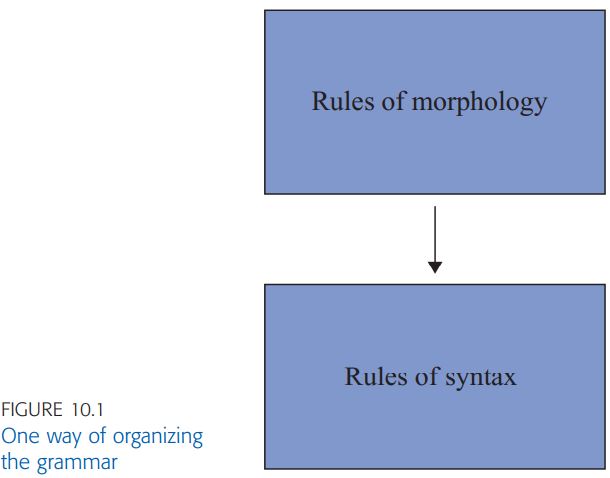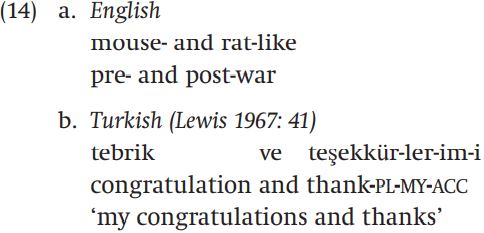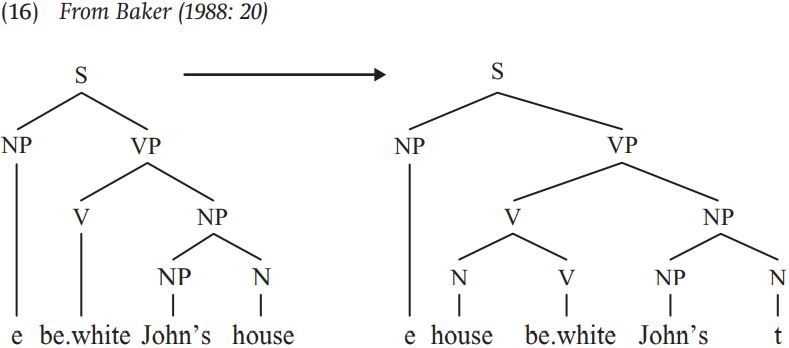
Lexical integrity
 المؤلف:
Rochelle Lieber
المؤلف:
Rochelle Lieber
 المصدر:
Introducing Morphology
المصدر:
Introducing Morphology
 الجزء والصفحة:
148-10
الجزء والصفحة:
148-10
 27-1-2022
27-1-2022
 1949
1949
Lexical integrity
We considered the relationship between morphology and syntax and saw several ways in which these two segments of the grammar are closely intertwined. The relationship between morphology and syntax indeed has given rise to one of the most interesting and longest-standing theoretical controversies among morphologists. Early in the history of generative morphology, several theorists proposed what has come to be called the Lexical Integrity Hypothesis. One version of this hypothesis is (12):

What this means is that syntactic rules – phrase structure or movement rules, for example – cannot look into words and manipulate their internal structures. The Lexical Integrity Hypothesis requires that morphological and syntactic rules be fundamentally different. Morphological rules are concerned with affixes and bases, with rules of reduplication and ablaut, and so on, that affect the internal structure of words. Rules of syntax take words as unanalyzable wholes and form them into phrases and sentences. One way of ensuring this separation between morphology and syntax that was proposed early in the history of generative morphology was to order morphological rules before syntactic rules, as if there were something like a linguistic assembly line that started with the smallest units of structure and proceeded to larger and larger units:

The model in figure 10.1 ensures the separation of morphology and syntax because syntax only gets to look at already-formed words. Many linguists no longer believe that rules operate in a strict ‘assembly-line’ fashion, but nevertheless continue to maintain that morphological and syntactic rules must be kept separate from one another.
The Lexical Integrity Hypothesis is both plausible and testable: indeed it makes a clear prediction that we should never find fully formed phrases or sentences inside words. If phrases are formed by syntactic rules and syntactic rules are separate from morphological rules, words should not contain phrases or sentences. However, there are some sorts of words that do seem to contain phrases and even sentences. Among these are phrasal compounds like those in (13):

It is also possible in some languages – including English – to conjoin two prefixes or two bases:

In English a few suffixes (-like, -ish) can take conjoined bases, and a few prefixes (pre-, post-, hyper-, hypo-) can themselves be conjoined and attached to a base. Turkish allows some of its inflectional endings to apply equally to two conjoined bases. If conjunction is a syntactic operation, and conjoined forms can occur inside words, then the strict separation of morphological and syntactic rules required by the Lexical Integrity Hypothesis cannot be correct.
Linguists have therefore proposed alternatives to the Lexical Integrity Hypothesis. Some linguists have proposed models in which limited interaction between morphology and syntax is possible. Others, however, have taken a more radical approach, arguing that there should be no separation between morphology and syntax, and that syntactic rules should be responsible for at least some sorts of word formation.
One sort of word formation that has been used to argue for this hypothesis is noun incorporation, which you looked at briefly. To refresh your memory, consider the Mohawk examples in (15) (Baker 1988: 20):


In (15a) the noun ‘house’ is part of an independent noun phrase (NP). In (15b), however, it has been incorporated into the verb ‘be white’ so that together they form a single word. In a syntactic analysis of noun incorporation (15b) starts out with the noun ‘house’ part of an NP with ‘John’s’. However, a syntactic movement rule plucks ‘house’ from its NP and attaches it to the verb ‘be white’, as (16) illustrates:3

There is a great deal that might be said about the pros and cons of this analysis, although we cannot do so here. I should point out, though, that while some linguists find the evidence for this analysis convincing, others are less convinced and prefer to work within theoretical models that treat noun incorporation as the result of morphological rules, and allow less interaction between morphology and syntax. As with many other theoretical issues in morphology, the jury is still out on the best way to treat the relationship between morphology and syntax.
 الاكثر قراءة في Morphology
الاكثر قراءة في Morphology
 اخر الاخبار
اخر الاخبار
اخبار العتبة العباسية المقدسة


